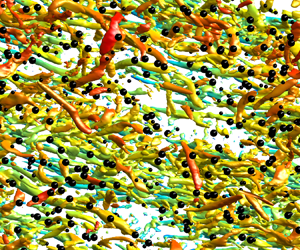Article contents
Turbulence modulation by charged inertial particles in channel flow
Published online by Cambridge University Press: 12 August 2024
Abstract

Large amounts of small inertial particles embedded in a turbulent flow are known to modify the turbulent statistics and structures, a phenomenon referred to as turbulence modulation. While particle electrification is ubiquitous in particle-laden turbulence and significantly alters particle behaviour, the effects of inter-particle electrostatic forces on turbulence modulation and the underlying physical mechanisms remain unclear. To fill this gap, we perform a series of point-particle direct numerical simulations of turbulent channel flows at a friction Reynolds number of approximately 540, laden with uncharged and charged bidisperse particles. The results demonstrate that, compared to flows laden with uncharged particles, the presence of inter-particle electrostatic forces leads to substantial changes in both turbulent intensities and structures. In particular, the inner-scaled mean streamwise fluid velocity is found to shift towards lower values, indicating a noticeable increase in fluid friction velocity. Turbulent intensities appear to be further suppressed through facilitating the particles to extract momentum from the fluid phase and increasing extra turbulent kinetic dissipation by particles. Importantly, the overall drag is enhanced by indirectly strengthening the contribution of particle stress, even though the contribution of the total fluid stress is decreased. On the other hand, the magnitude of the large-scale motions is weakened by simultaneously reducing turbulent production and increasing particle feedback around the scales of the large-scale motions. Meanwhile, the average streaky fluid structures in the streamwise–spanwise planes and inclined fluid structures in the streamwise–wall-normal planes become expanded and flattened, respectively.
JFM classification
- Type
- JFM Papers
- Information
- Copyright
- © The Author(s), 2024. Published by Cambridge University Press
References
- 3
- Cited by



